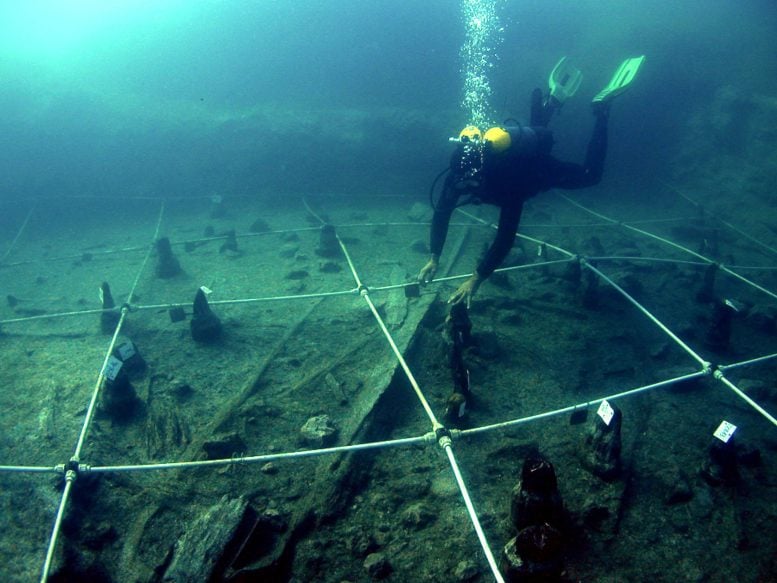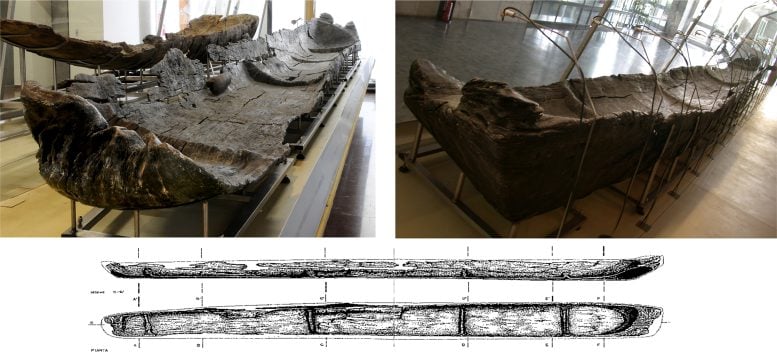
Research uncovering technologically sophisticated boats used over 7,000 years ago in the Mediterranean demonstrates early European civilizations’ advanced seafaring skills, suggesting a profound knowledge of boat construction and potential avenues for future archaeological discoveries. Excavation of Canoe 5. Credit: Gibaja et al., 2024, PLOS ONE, CC-BY 4.0
Italian canoes exhibit the early development of sophisticated nautical technology.
Over 7,000 years ago, people navigated the Mediterranean Sea using technologically sophisticated boats, according to a study recently published in the open-access journal PLOS ONE by Juan F. Gibaja of the Spanish National Research Council, Barcelona and colleagues.
Many of the most important civilizations in Europe originated on the shores of the Mediterranean Sea. During the Neolithic, communities clearly traveled and traded across the water, as evidenced by watercraft in the archeological record and the presence of settlements on coasts and islands. In this study, Gibaja and colleagues provide new insights into the history of seafaring technology through analysis of canoes at the Neolithic lakeshore village of La Marmotta, near Rome, Italy.
Excavation at this site has recovered five canoes built from hollowed-out trees (dugout canoes) dating between 5700-5100BC. Analysis of these boats reveals that they are built from four different types of wood, unusual among similar sites, and that they include advanced construction techniques such as transverse reinforcements.
One canoe is also associated with three T-shaped wooden objects, each with a series of holes that were likely used to fasten ropes tied to sails or other nautical elements. These features, along with previous reconstruction experiments, indicate these were seaworthy vessels, a conclusion supported by the presence at the site of stone tools linked to nearby islands.

Canoe Marmotta 1. On display in the Museo delle Civiltà in Rome. Credit: Gibaja et al., 2024, PLOS ONE, CC-BY 4.0
The Significance of Neolithic Canoe Construction
The authors describe these canoes as exceptional examples of prehistoric boats whose construction required a detailed understanding of structural design and wood properties in addition to well-organized specialized labor. Similarities between these canoes and more recent nautical technologies support the idea that many major advances in sailing were made during the early Neolithic. The authors suggest there may be more boats preserved near La Marmotta, a potential avenue for future research.
The authors add: “Direct dating of Neolithic canoes from La Marmotta reveals them to be the oldest in the Mediterranean, offering invaluable insights into Neolithic navigation. This study reveals the amazing technological sophistication of early agricultural and pastoral communities, highlighting their woodworking skills and the construction of complex vessels.”
Reference: “The first Neolithic boats in the Mediterranean: The settlement of La Marmotta (Anguillara Sabazia, Lazio, Italy)” by Juan F. Gibaja, Mario Mineo, Francisco Javier Santos, Berta Morell, Laura Caruso-Fermé, Gerard Remolins, Alba Masclans and Niccolò Mazzucco, 20 March 2024, PLOS ONE.
DOI: 10.1371/journal.pone.0299765
Funding: The research has been carried out in the collaboration agreement between the Museo delle Civiltà and the Spanish Scientific Research Council (centers in Barcelona IMF-CSIC and Rome EEHAR-CSIC) and the National Accelerators Centre (CNA) in Seville. Several projects have resulted from this collaboration funded by the Ministry of Science and Innovation and State Research Agency of Spain, Marie Curie Europe Program, JdC-Formación 2020 AEI Program, and Ministry for University and Research of Italy: PID2020-112513RB-I00/AEI/10.13039/501100011033, HAR2016-75201-P, PIAR-201818008, PIAR-201918010, QUANT-792544, PICT-2015-2541 and Rita Levi Montalcini project ‘AGER’. The funders had no role in study design, data collection and analysis, decision to publish, or preparation of the manuscript.









